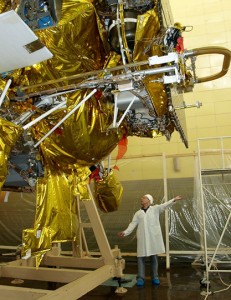
The Russian Phobos-Ground probe was intended to land on the Martian moon Phobos, and bring back soil samples to Earth in a 2,5 year mission. The craft started it’s journey from Site 45 in Baikonur Cosmodrome, Kazakhstan, on November. 8, 2011, when it was launched with a two-stage Zenit rocket (Zenit-2SB41.1). After a flawless liftoff, the first separation of the rocket went according to plan. Unfortunenaly issues occurred during the second separation of the two-stage rocket, leaving the Phobos-Grunt in an elliptical orbit with a perigee (lowest point) of 207 kilometers above the Earth surface and an apogee (highest point) of 347 kilometers.
Even after several attempt to salvage the mission, Roscosmos, the Russian space agency finally had to admit defeat and the Phobos-Ground probe was left stuck in an orbit around earth. The €129m ($170m) Phobos-Ground probe is now expected to fall back to Earth between 6 and 19 January. The craft weighs 13.2 tonne, including 11 tonnes of highly toxic fuel. But Roscosmos expect that only 20 to 30 fragments weighing a total of up to 200kg (440lb) will survive the fiery plunge and shower the Earth’s surface. Where they will land can only be calculated a few days beforehand, Roscosmos said in a statement.
Experts have warned that if the highly toxic fuel have become frozen, some could survive re-entry into Earth’s atmosphere, and pose a serious threat if it fell over populated areas. Roscosmos say that they are sure that all fuel will burn on re-entry some 100km (about 60 miles) up. The 10kg of cobalt-57, a radioactive metal in one of the craft’s instruments, should not pose a threat of contamination.
Ever since the Mars probe became stuck in an orbit around earth, Roscosmos have tried to salvage the mission and initiate a launch out of earths atmosphere. Right from the start it turned out to be difficult to locate and also communicate with the stranded Phobos-Grunt. Vladimir Popovkin, head of the Russian space agency, admitted that chances of salvaging the mission was low, but further attempts to communicate with the probe would continue until the closing of the window for departure to Mars at the beginning of December 2011. Phobos-Grunt mission objectives later had to be officially abandoned, as the window of opportunity to send the spacecraft to Mars (in case it had stayed on the ground) closed on November 21. During the night from November 22 to November 23 Moscow Time (20:25 GMT on November 22), Phobos-Grunt finally communicated with a ground station in Perth, Australia, operated by the European Space Agency (ESA). At this time it was to late to salvage the mission, and the signal revived was also very weak.
